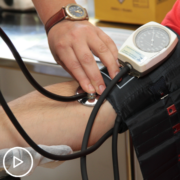How Can CAR T-Cell Therapy Be Explained to Patients and Families?
How Can CAR T-Cell Therapy Be Explained to Patients and Families? from Patient Empowerment Network on Vimeo.
How can patients and families be educated about CAR T-cell therapy? Expert Dr. Sikander Ailawadhi from Mayo Clinic discusses the approach he takes to explaining the treatment to those new to learning about CAR T.
See More from [ACT]IVATED CAR T
Related Resources:
Transcript:
Lisa Hatfield:
Dr. Ailawadhi, how do you explain CAR T therapy to your patients and families hearing about it for the first time?
Dr. Sikander Ailawadhi:
Lisa, that’s a very important question of how we explain CAR T to a patient, or their family members, of course, their caregivers. If we just take a step back and think about it, this is the most closed way are to science fiction in treating multiple myeloma. And so obviously, explaining that in terms that makes sense to them, gets them excited, but also gives them, one, the promise of the treatment and two, the appropriate details of potential side effects, et cetera, so that the patient can take an informed decision.
That boils down to the principle of shared decision making that all of us keep vying for. So the way I explain is that CAR T-cell therapy is based on the fact of taking a patient’s immune system, training it to go against that particular cancer and giving that hyper-activated or that activated trained immune system back to the patient.
And what we typically…the way I would explain that is that, some of these patients have had stem cell transplants before. It’s also important for me to keep comparing and contrasting with that. We explain to the patients that they typically undergo some testing to identify whether they’re candidates for CAR T or not, based on organ function, et cetera. Then we collect the T cells from their bloodstream. But as against stem cell transplant where the collection could have taken three to five days, T-cell collection is done only in one day in one sitting, outpatient.
And then those T cells are sent for manufacturing. During that time, the patient, we work on controlling their disease, and then those T cells are genetically modified. Some DNA for a target that is present on the myeloma cells, that is inserted into the T cells’ DNA.
The genetic material of a seeker is put into the T cells. Then those T cells are multiplied in the lab, and are sent back to us a few weeks later from the collection as a bag as the drug. And this has given back to the patients. Now, those trained activated T cells, have that seeker that they can specifically go and target a particular marker on the myeloma cells. In the case of both the CAR T cells that are currently FDA-approved, that, target on the myeloma cells is called BCMA. B-cell maturation antigen. So while the myeloma had that BCMA, the myeloma was growing because our immune system was not able to control it.
Now, the new…these activated T cells that came back or trained T cells, they have a seeker that can specifically go seek out the BCMA attached to it and kill those myeloma cells. And by the way, this BCMA is almost universally present on the myeloma cells. If I have to keep in mind an activation tip for this question of how do I explain CAR T-cell therapy is we take your immune system, as in the patient’s immune system, that immune system is trained to specifically go against the myeloma and is given back to the patients so that now those T cells are able to go and kill the myeloma, which was growing uncontrolled previously.













